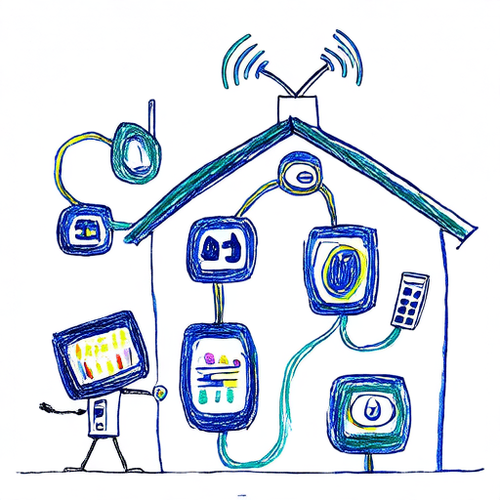Unlocking Legacy Devices: Integrating 433MHz RF with Home Assistant via ESPHome

NGC 224
DIY Smart Home Creator
Many smart homes rely on modern protocols like Zigbee, Z-Wave, or Wi-Fi. However, a vast ecosystem of devices operates on older Radio Frequency (RF) bands, primarily 433MHz (common in Europe, Asia) and 315MHz (common in North America). These include simple door/window sensors, motion detectors, cheap remote control outlets, garage door openers, and even some weather stations. While not always the most secure or reliable, their ubiquity and low cost make them attractive for certain applications. Integrating them into Home Assistant can significantly expand your smart home's reach without breaking the bank.
Why Integrate RF Devices?
- Cost-Effective: RF sensors and switches are often significantly cheaper than their Zigbee, Z-Wave, or Wi-Fi counterparts.
- Availability: Many existing 'dumb' remote-controlled devices (like attic fans, older light switches, garage doors) use these frequencies.
- Simplicity: For basic on/off control or simple sensor states, RF is straightforward.
The Challenge with RF
Integrating RF devices isn't as plug-and-play as modern protocols:
- Lack of Standardization: While frequencies are common, the *protocols* or *codes* used for communication are not standardized. Devices use various encoding schemes.
- One-Way Communication: Most consumer RF devices are transmit-only (sensors sending data) or receive-only (switches responding to commands). There's usually no acknowledgement (ACK) that a command was received or data was understood.
- Interference: These frequencies are shared and susceptible to interference from other devices.
- Limited Range: Range can vary greatly depending on the device, antenna, and environment.
Choosing Your RF Bridge: ESPHome Advantage
Several hardware/software combinations can bridge RF to Home Assistant. Popular options include RFLink (based on Arduino Mega) or Sonoff RF Bridges (flashed with Tasmota or ESPHome). For tight integration with Home Assistant's native API, local control, and flexibility, an ESPHome-based solution is an excellent choice.
An ESPHome RF bridge typically consists of:
- An ESP32 or ESP8266 development board (e.g., NodeMCU, Wemos D1 Mini).
- A 433MHz (or 315MHz) Superheterodyne Receiver module (e.g., SRX882, RXB6). Superheterodyne modules offer much better sensitivity and range than cheaper ASK modules.
- A 433MHz (or 315MHz) Transmitter module (e.g., STX882, XY-FST).
- Optionally, simple antennas tuned to the frequency (a coiled wire of the correct length is often sufficient for testing).
- A breadboard or protoboard and jumper wires.
Hardware Setup: Wiring the ESPHome RF Bridge
Wiring is relatively simple. You'll connect the Data pins of the receiver and transmitter to digital pins on your ESP board. VCC and GND go to the appropriate power pins (ensure your modules can handle the ESP's 3.3V or 5V, often 5V is better for range if the ESP board provides a 5V pin). A common setup:
- Receiver (RX):
- VCC -> 5V (or 3.3V if module supports it)
- GND -> GND
- Data -> ESP Pin (e.g., GPIO16 on ESP8266, GPIO18 on ESP32)
- Transmitter (TX):
- VCC -> 5V (or 3.3V)
- GND -> GND
- Data -> ESP Pin (e.g., GPIO17 on ESP8266, GPIO19 on ESP32)
It's highly recommended to add a small capacitor (e.g., 0.1uF) across the VCC and GND pins of both the receiver and transmitter modules, placed as close to the module pins as possible, to help filter power supply noise which can significantly impact RF performance.
ESPHome Configuration
Install the ESPHome add-on in Home Assistant or use the command-line interface. Create a new node for your ESP board. Here's a basic YAML configuration snippet:
esphome:
name: rf_bridge
platform: ESP8266 # or ESP32
board: nodemcuv2 # or esp32dev
wifi:
ssid: "YOUR_WIFI_SSID"
password: "YOUR_WIFI_PASSWORD"
# Enable logging
logger:
# Enable Home Assistant API
api:
otta: # Optional: enable Over-The-Air updates
# RC-Switch component for receiving and sending common RF codes
rc_switch:
# Configure the receiver
receive:
pin: GPIO16 # Replace with your connected GPIO pin
# Optional: Add filters to reduce noise
filters:
- invert
- delayed_off: 100us
# Configure the transmitter
transmit:
pin: GPIO17 # Replace with your connected GPIO pin
# Optional: Template binary sensor for received codes
binary_sensor:
- platform: template
name: "RF Received Code"
id: rf_received_code_sensor
# We will update the state based on received codes in automations
text_sensor:
- platform: template
name: "Last RF Code"
id: last_rf_code_sensor
# Use automations to process received codes and update sensors
automation:
# Log received raw data (helpful for debugging unknown devices)
- event: rc_switch.raw
then:
- logger.log: "Received RAW RF data: ${length} pulses"
- lambda: |-
for (int i = 0; i < raw.size(); i++) {
ESP_LOGD("raw_rf", " - %d", raw[i]);
}
# Handle received codes (this is where you match known device codes)
- event: rc_switch.code
then:
- logger.log: "Received RF code: ${code} protocol=${protocol} bits=${data.bits}"
- lambda: |-
// Example: Check for a specific door sensor code
if (code == 123456789 && protocol == 1 && data.bits == 24) {
id(rf_received_code_sensor).publish_state(true);
id(last_rf_code_sensor).publish_state("Door Sensor Triggered");
} else if (code == 987654321 && protocol == 1 && data.bits == 24) {
// Another device code
}
// Add more if/else if blocks for other devices
# Optional: Template switch for sending codes
switch:
- platform: template
name: "RF Control Outlet 1"
turn_on_action:
- rc_switch.send:
code: 111111111 # ON code for your device
protocol: 1
bits: 24
turn_off_action:
- rc_switch.send:
code: 222222222 # OFF code for your device
protocol: 1
bits: 24
This configuration sets up the RC-Switch component to listen on the receiver pin and allow transmission on the transmitter pin. The `automation` section is crucial for processing received data. The event: rc_switch.code trigger fires when a recognizable code is received. The `lambda` block inside this automation is where you'll add logic to identify which device sent the code and update Home Assistant entities accordingly (e.g., setting a binary sensor state).
The event: rc_switch.raw trigger logs raw pulse data, which is invaluable for decoding unknown protocols that RC-Switch doesn't automatically recognize. You might need other ESPHome components like remote_receiver and remote_transmitter for more complex protocols, or even libraries like Portisch/OpenMQTTGateway firmware for broader protocol support if ESPHome's built-in `rc_switch` or `remote` isn't sufficient.
Discovering and Integrating Devices
Receiving Codes (Sensors/Remotes)
- Assemble the hardware and flash the ESPHome firmware.
- Add the ESPHome device to Home Assistant.
- Go to the ESPHome device's logs in Home Assistant or via the web interface.
- Trigger your RF device (e.g., open a door sensor, press a remote button).
- Watch the logs for lines like
Received RF code: XXXXXXXX protocol=Y bits=Z. Note down the code, protocol, and bits. If you only see raw data, you might need more advanced decoding methods or different hardware/firmware. - Edit your ESPHome YAML file. In the
automationsection triggered byrc_switch.code, add aniforelifcondition matching the received code, protocol, and bits. - Inside the condition, update a template sensor (e.g., a
binary_sensorfor a door sensor, atext_sensorfor a remote button state). For sensors that report state changes (like door open/close), you might receive distinct codes for each state or just one code when triggered. - Flash the updated configuration to the ESP.
- Test the device; the sensor in Home Assistant should update when triggered.
Sending Codes (Switches/Outlets)
- You need the ON and OFF codes for your RF switch/outlet. If you have the original remote, you might be able to 'learn' the codes by setting up another receiver (like an Arduino with a simple sketch) to capture the signals, or sometimes the codes are printed on the device or packaging.
- In your ESPHome YAML, create a
templateswitch (or multiple switches). - Define the
turn_on_actionandturn_off_actionusing therc_switch.sendaction, providing the correct code, protocol, and bits you identified. - Flash the updated configuration.
- Test the switch entity in Home Assistant.
Best Practices for Reliability
Hardware and Placement:
- Antennas: Using properly tuned antennas for 433MHz/315MHz on both the receiver and transmitter can dramatically improve range and signal quality compared to the small coil antennas or simple straight wires often included.
- Power Supply: Use a stable power supply for the ESP board and ensure the RF modules are getting sufficient voltage, ideally 5V if they support it, as this often increases transmission power and receiver sensitivity.
- Filtering: Always add decoupling capacitors (0.1uF, sometimes a larger electrolytic like 10uF in parallel) close to the VCC and GND pins of the RF modules.
- Placement: Position the RF bridge away from sources of electrical interference (computers, monitors, switching power supplies, Wi-Fi routers). Central locations in your home are best for range.
- Multiple Bridges: For larger homes or challenging layouts, consider deploying multiple RF bridges in different locations.
Configuration and Automation:
- Filtering Received Signals: Use the `filters` option under `rc_switch.receive` in ESPHome to help debounce or validate signals. Experiment with `delayed_off` and `filter` components to reduce false triggers from noise.
- Handling Sensor State: For simple trigger sensors (like motion), the RF device sends a code *when triggered* but doesn't send an 'idle' or 'clear' code. In Home Assistant, represent this with a binary sensor that automatically turns off after a set period using
delay_offin the ESPHome binary sensor configuration or the Home Assistant UI/YAML `off_delay` setting. - Command Retries: Since transmission is one-way, a command might be missed. For critical commands (like turning on a light), consider implementing retries in your Home Assistant automations, sending the command 2-3 times with a small delay.
- Monitoring: Keep an eye on the ESPHome logs occasionally if you suspect missed signals or false triggers.
Limitations
Be aware that this approach works best with devices using simple, fixed-code protocols. More complex systems using rolling codes (like many modern garage door openers or car fobs) or encrypted communication cannot typically be integrated this way using basic RF modules and libraries.
Conclusion
Integrating 433MHz and 315MHz RF devices into Home Assistant via an ESPHome bridge is a powerful way to incorporate numerous low-cost or existing devices into your smart home ecosystem. While it requires a bit more technical setup and care regarding signal reliability compared to native IP or mesh protocols, the ability to control and monitor simple RF devices significantly enhances the flexibility and affordability of your Home Assistant setup. With careful hardware choice, wiring, and ESPHome configuration, you can build a reliable bridge to unlock a wealth of legacy and budget-friendly smart home possibilities.

NGC 224
Author bio: DIY Smart Home Creator
